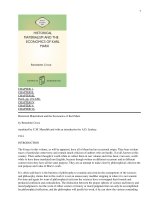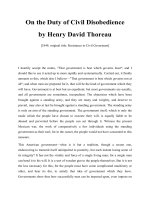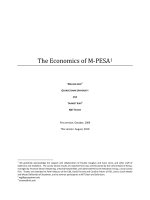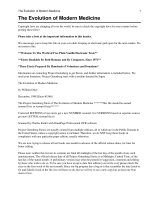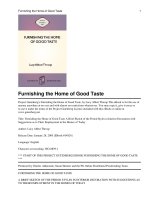The Economics of M‐PESA pot
Bạn đang xem bản rút gọn của tài liệu. Xem và tải ngay bản đầy đủ của tài liệu tại đây (1.37 MB, 20 trang )
TheEconomicsofM‐PESA
1
W
ILLIAMJACK
2
G
EORGETOWNUNIVERSITY
AND
T
AVNEETSURI
3
MIT
SLOAN
Firstversion:October,2009
Thisversion:August,2010
1
We gratefully acknowledge the support and collaboration of Pauline Vaughan and Susie Lonie, and other staff of
SafaricomandVodafone.ThesurveywhoseresultsarereportedherewascommissionedbytheCentralBankofKenya,
managedbyFinancialSectorDeepening,aNairobi‐basedNGO,andadministeredbytheSteadmanGroup,alocalsurvey
firm.ThanksareextendedtoPeterMwauraoftheCBK,DavidFerrandandCarolinePulverofFSD,andtoCarolMatiko
andMosesOdhiamboofSteadman,andtoseminarparticipantsatMITSloanandSafaricom.
2
3
JackandSuri 2
I.Introduction
Mobilephonetechnologyhasreducedcommunicationcostsinmanypartsofthedevelopingworldfrom
prohibitivelevelstoamountsthatare,incomparison,virtuallytrivial.Nowherehasthistransformation
beenasacuteasinsub‐SaharanAfrica,wherenetworksof bothfixedline communicationandphysical
transportation infrastructure are often inadequate, unreliable, and dilapidated.While mobile phone
callingratesremainhighbyworldstandards,thetechnologyhasallowedmillionsofAfricanstoleap‐frog
theland‐lineenrouteto21
st
centuryconnectivity.
Earlyoninthisrevolution,cellphoneusersfiguredoutthattheycouldeffectivelytransfermoneyacross
wide distances.Phone companies have long allowed individual s to purchase “air‐time” (i.e., pre‐paid
cell phone credit that can be used for voice or
SMS communication) and to send this credit to other
users.Itwasasmallstepfortherecipientusertoon‐sellthereceivedair‐timetoalocalbrokerinreturn
forcash,orindeedforgoodsandservices,thuseffectingatransferofpurchasingpowerfromtheini tial
sendertotherecipient.
InMarch2007,theleadingcellphonecompanyinKenya,Safaricom,formalizedthisproce durewiththe
launch of M‐PESA, an
SMS‐based money transfer system that allows individuals to deposit, send, and
withdrawfundsusingtheircellphone.M‐PESAhasgrownrapidly,currentlyreachingapproximately38
percentofKenya’sadultpopulation,andiswidelyviewedasasuccessstorytobeemulatedacrossthe
developingworld.
Thispaperprovidesadescriptionoftheserviceandareviewofthepotentialeconomiceffectsprimarily
atthehouseholdlevel,butalsointermsofmacroeconomicandmonetaryaggregates.Itthenprovides
adetailedportrayalofpatternsofuseacrossurbanandruralpopulations,usingdatafromthefirstlarge
householdsurveyfocusedonmoneytransferservicesinKenya.
4
II.Context
MobilephonesandmobilebankinginKenya
Theadoptionofmobilephoneshasoccurredatperhapsthefastestrateand tothedeepestlevelofany
consumer‐level technology in history.
Figure 1 illustrates the speed of adoption compared with a
variety of product innovations.While cumulative forcesare of course important, making it difficult to
compare directly across innovations, it is nonetheless informative to note that cell phones have been
adoptedmorethanfivetimesasfastasfixedlinetelephoneservices,whichtook100yearstoreach80
percentofcountrypopulations.
4
Mobilepayment systems havealso been developed in other developing countries.Inthe Philippines Globe Telecom
operates GCASH, and in South Africa WIZZIT facilitates mobile phone‐based transactions through the formal banking
system(IvaturyandPickens,2006).SimilarlymobilebankingtechnologieshavedevelopedinSudanandGhana,andina
numberofcountriesisLatinAmericaandtheMiddleEast(Mas,2009).Forrelatedoverviews,seealsoMasandRotman
(2008) and Mas and Kumar (2008), as well as other publications of the Consultative Group to Assist the Poor, at
www.cgap.org
.
JackandSuri 3
Figure1:Technologyadoptionforselectinnovations(numberyearstoreach80%coverage)
5
One of the reasons mobile phone technology has spread quickly is that it has followed other
technologiesthatmayhaveeasedtheway.
Figure2
confirmsthissequencingpropertyislikelyatwork,
at least in the US: many of the new technologies that were introduced before about 1950 (with the
exceptionofradio)wererelativelyslowtodiffusethroughthepopulation,whereasthoseintroducedin
the second half of the century saw generally steeper adoption rates.Nonetheless, the speed of
adoptionofcell‐phones,especiallyinthedevelopingworld,remainsunprecedented.
Figure2:Technologyadoptionisgettingfaster
6
5
DatafromWorldBank.
6
Source:NewYorkTimes,February10,2008.
0 20 40 60 80 100 120 140
Railways
Steel(openhearth)
Telephones
Steel(electrichearth)
Radio
Aviation
Personalcomputers
Internetuse
CATscan
Mobilephones
Years
JackandSuri 4
ThespreadofmobilephonetechnologyhasbeenespeciallyrapidandbroadinAfricawherepenetration
ratesstood atsome 32percentin 2008,still well below the globalaverage of 60percentatthat time,
but much hig her than the 7 percent coverage rate that prevailed just four years before.This pattern
stands in contrast to the adoption of other technologies such as improved seed and fertilizer, which
have been frustratingly weak.Since Solow’s (1956) seminal contribution to the theory of economic
growth, and following later developments (e.g., Romer 1986 and Lucas, 1988), economists have
understood that higher rates of adoption of modern technologies may accelerate the developme nt
process.
In Kenya, the first mobile phone companies were publicly owned, and began operations in the mid‐
1990sonasmallscale.OvertimemobilephonesinKenyahaveeclipsedlandlinesastheprimarymeans
oftelecommunication:whilethenumberoflandlineshadfallenfromabout3 00,000in1999toaround
250,000by2008,mobilephonesubscriptionshadincreasedfromvirtuallyzerotonearly17millionover
the same time period (
Figure 3).
7
Assuming an individual has at most one cell phone,
8
47% of the
population,orfully83%ofthepopulation15yearsandolder,haveaccesstomo bilephonetechnology.
Figure3:PhoneuseinKenya
Safaricom, which began operations in 1997, is currently the largest mobile phone operator in Kenya,
controling nearly 80 percent of the market, ahead of its two nearest rivals (Zain and Orange).Recent
7
Figure3includesinformationontheshareofoursamplewhohadstartedusingacellphonebyyear.Theevolutionof
this figure follows closely that from the aggregate data on cell phone use, providing partial validation of our sampling
methodology.
8
Thisisnotquitetrue,assome individualsowntwo(ormore)phones,soastotakeadvantageofdifferenttariffpolicies
ofthecompetingproviders.
0%
20%
40%
60%
80%
100%
0
2
4
6
8
10
12
14
16
18
1998 2000 2002 2004 2006 2008 2010
Percentofoursample
Millionsofsubscribers
Fixedlines
Mobilelines
M‐PESAusers
Yearoffirstcellphoneuse(ourdata,righthandaxis)
JackandSuri 5
andprospectiveentryintothesectoris expectedto putasqueezeonSafaricom’s marketshare,which
somecomme ntators(includingitschiefexecutive)expecttofalltoaround65percentoverthenext3to
4years.
9
In April 2007, following a donor‐funded pilot project, Safaricom launched a new mobil e phone‐based
payment and money transferservice, known as M‐PESA.
10
The service allows users to depositmoney
into an account stored on their cell phones, to send balances using
SMS technology to other users
(includingsellersofgoodsandservices), andtoredeemdepositsforregularmoney.Charges,deducted
fromusers’accounts,areleviedwhene ‐floatissent,andwhencashiswithdrawn.
M‐PESAhasspreadquickly,andhas becomethemostsuccessfulmobilephone‐basedfinancialservicein
the developing world.
11
The average number of new registrations per day exceeded 5,000 in August
thatyear,andreachednearly10,000inDecember(see
Figure4).ByAugust2009,astockofabout7.7
millionM‐PESAaccountshadbeenregistered.Ignoringmultipleaccountsandthoseheldbyforeigners,
thissuggests thatabout38percent oftheadultpopulationhasgained accesstoM‐PESAinjustover 2
years.
Figure4:AveragedailygrowthinM‐PESAregistrationsbymonth
SincethelaunchofM‐PESAinMarch2007,waryofregulationbytheCentralBankofKenya,Safaricom
hasbeenatpainstostressthatM‐PESAisnotabank.Ontheotherhand,theubiquityofthecellphone
across both urban and rural parts of the country, and the lack of penetration of regular banking
9
SeereportbyInternationalTelecommunicationUnion, />D/ict/newslog/Safaricoms+Market+Share+To+Dip+From+80+To+65+As+Com petition+Toughens+Kenya.aspx.
10
PesaisKiswahilifor“money”–hence M[obile]‐Money.
11
Similar services in Tanzania and South Africa, for example, have penetrated the market much less.See Mas and
Morawczynski(2009).
0
5,000
10,000
15,000
Numbernew
usersperday
JackandSuri 6
services,
12
led to hopes that M‐PESA accounts could substitute for bank accounts, and reach the
unbanked population.Our data, presented in more detail in the next section, suggest this is partially
true, although M‐PESA has been adopted by both the banked and unbanked in roughly equal
proportions.
13
While the sustained growth in M‐PESA registrations is notable, the volume of financial transactions
mediatedthroughM‐PESAshouldnotbeexaggerated.
Table1reportsthatthevolumeoftransactions
effectedbetween banks under theRTGS(Real TimeGrossSettlement] method is nearly 700 times the
dailyvalue transacted through M‐PESA.Onthe otherhand, the average mobiletransaction is abouta
hundred times smaller than the average check transaction (Automated Clearing House, or ACH), and
evenjusthalfthesizeoftheaverageAutomaticTellerMachine(ATM)transaction.
14
ThusM‐PESAisnot
designedtoreplaceallpaymentmechanisms,buthasfoundandfilled anicheinthemarke tinwhichit
providessignificantlyenhancedfinancialservices.
Table1:Dailyfinancialtransactions,Oct2007‐Sept2008
15
RTGS ACH ATM Mobile
Valueperday(billionKSh) 66.3 8.5 1.0 0.1
Transactionsperday(thousands) 1.0 39.2 180.2 107.2
Valuepertransaction(millionKSh) 64.67 0.216 0.006 0.003
HowdoesMPESAwork
AlthoughM‐PESAdoesnotpayinterestondeposits,anddoesnotmakeloans,itcanusefullybethought
ofasabankthatprovidestransactionservicesandthathasoperated,untilrecently,inparallelwiththe
formalbankingsystem.
SafaricomacceptsdepositsofcashfromcustomerswithaSafaricomcellphoneSIMcardandwho have
registeredas M‐PESAusers.Registration is simple,requiring anofficial formof identification (typically
the national ID card held by all Kenyans, or a passport) but no other validation documents that are
typicallynecessarywhenabankaccountisopened.Formally,inexchangeforcashdeposits,Safaricom
issues a commodity known as “e‐float,” measured in the same units as mon ey, which is held in an
account under the user’s name.This account is operated and managed by M‐PESA, and records the
quantityofe‐floatownedbyacustomeratagiventime.Thereisnochargefordepositingfunds,buta
slidingtariffisleviedonwithdrawals(forexample,thecostofwithdrawing$100isabout$1).
16
Figure
12
In2006itwasestimatedthat18.9percentofadultsuseda bankaccountorinsuranceproduct,andby2009thishad
increasedto22.6percent.(FinaccessI.)
13
Inthetimesinceoursurveywasfirstadministered,therehasbeensignificantgrowthinthenumberofindividuals,and
households,withabankaccount,duetotheexpansionofsuchinstitutionsasEquityBankandFamilyBank.Inaddition,
anumberofbankshavevery recentlyallowedconsumerstolinkthereM‐PESAandbankac counts.Howthesechanges
haveaffectedtherelationshipbetweenM‐PESAregistrationandaccesstobankingservicesremainstobeseen.
14
ThesedatarefertoaperiodbeforeM‐PESAcouldbeusedatATMs.
15
Source: Central Bank of Kenya, presentation at conference on Banking & Payment Technologies East Africa, 17‐19
February2009,Nairobi.
16
Thecompletetariffscheduleisavailableat
/>.
JackandSuri 7
5illustratesthescheduleoftotalnettariffsforsendingmoneybyM‐PESA,WesternUnionandPostapay
(operated by the Post Office).The M‐PESA tariffs include withdrawal fees, and are differentiated
accordingtoreceiptbyregisteredandnon‐registereduser.
Figure5:TotalnettariffratesfordepositingandsendingmoneybyPostapayandbyM‐PESA
toaregistereduserandtoanon‐registereduser
E‐float can be transferred from one customer’s M‐PESA account to another using SMS technology, or
sold back to Safaricom in exchange for money.Originally, transfers of e‐float sent from one user to
another were expected to primarily reflect unrequited remittances, but nowadays, while remittances
are still an important use of M‐PESA, e‐float transfers are often used to pay directly for goods and
services,fromelectricitybillstotaxi‐cabfares.Thesenderofe‐floatischargedaflatfeeofabout40US
cents,buttherecipientonlypayswhens/hewithdrawsthefunds.
Table2:Safaricomcelltowerdistributionbyprovince
Province Towers Population
per tower
Area per
tower (sq mi)
Nairobi
584 4,872 0.5
Rift Valley
375 22,448 179.0
Coast
247 12,046 130.7
East
214 24,871 288.5
Central
206 19,048 24.7
Nyanza
162 30,771 38.5
Western
90 46,122 35.9
North-East
45 29,467 1,088.8
Total
1923 17,653 117.0
Feesarechargedtotheuser’saccount,fromwhiche‐floatisdeducted.Additionalcashfeesareofficiallynotpermitted,
butthereisevidencethattheyaresometimeschargedonaninformalbasisbyagents.
0
200
400
600
800
1,000
1,200
1,400
0 10,000 20,000 30,000 40,000
Tariff
Amountdepositedandsent
Postapay M‐PESA:Regtonon‐reg
M‐PESA:Regtoreg WesternUnion
JackandSuri 8
Transfers are, of course, subject to availability of network coverage, which has expanded consistently
overthepastde cade.Thereare nownearly2,000 Safaricomtowersacrossthe country(in additionto
towers operated by competing providers), conce ntrated in areas of high population density.
Table 2
givesabreakdownbyprovince,andthemostrecentnetworkcoveragemapisshownin
Figure6
.
Figure6:Safaricomnetworkcoverage,September2009
17
To facilitate purchases and sales of e‐float, M‐PESA maintains and operates an extensive network of
over12,000agentsacrossKenya.Ascanbeseenin
Figure7
,thegrowthofthisnetworklaggedbehind
that of the customer base for the first year of M‐PESA’s operation during which time the number of
users per agent increase d five‐fold, from a low of 200 to a high of 1,000.But since mid‐2008, agent
growthhasacceleratedandthenumberofusersperagenthasfallenbacktoabout600.
RegisteredM‐PESAuserscanmakedepositsandwithdrawalsofcash(i.e.,makepurchasesandsales of
e‐float) with the agents, who receive a commission on a sliding scale for both deposits and
withdrawals.
18
M‐PESAagents holde‐float balances on their own cell‐phones, purchased ei ther from
Safaricom
19
orfromcustomers,andmaintaincashontheirpremises.Agentsthereforefaceanon‐trivial
inventory management problem, having to predict the time profile of net e‐float nee ds, while
maintainingthesecurityoftheiroperations.
17
Source: />18
The commission amounts are non‐linear (and concave) in the size of the transaction.Some reports suggest that in
response to this, agents encourage customers to split their transactions into multiple pieces, thereby increasing the
overallcommission.
19
M‐PESArequiresthateachagenthasabankaccount,sothatfundscanbetransferredeasilybetweenthem.
JackandSuri 9
Figure7:Expansionoftheagentnetwork
20
Inpractice,agentsareorganizedinto groups.Originally,M‐PESArequiredthatagentgroupsoperatedin
atleastthreedifferentphysicallocations,sothattheprobabilityofimbalancesarisingwithinthegroup
could be minimized.There are currently three agent group models in operationIn the first, one
member of the agent group (the “head‐office”) deals directly with M‐PESA, while subsidiary agents,
which are owned by the head office, manage cash and e‐float balances through transactions with the
head‐office.BoththeheadofficeandtheagentscantransactdirectlywithM‐PESAusers.
ThesecondmodelunderwhichagentsareorganizedintogroupsistheAggregatormodel.Thismodelis
similar to the first, with the aggregator acting as a head office, dealing directly with Safaricom and
managing the cash and e‐float balances of agents.However, the agents can be independently owned
entities,withwhichtheaggregatorhasacontractualrelationship.
A final and more recent model allows a bank branch, referred to as a “super‐agent,” to perform the
functions of the aggregatorof the second model.The bran ch manages cash and e‐float balances of a
group of non‐bank M‐PESA agents, but unlike the regular and aggregator models, the bank does not
tradee‐floatdirectlywithM‐PESAusers.
The super‐agentmodel is one example of the integration of M‐PESA services into the bankingsystem.
Otherdevelopmentsinthisveinhaveseenuserswithaccountsat certaincommercialbanks(about72%
of user households in our data have at least one bank account – see
Table below), being able to
transferfundsbetweenthoseaccountsandtheirM‐PESAaccounts,oftenviaATMs.
20
Source:Safaricom.
0
200
400
600
800
1000
1200
0
2000
4000
6000
8000
10000
12000
14000
Apr‐07
Jun‐07
Aug‐07
Oct‐07
Dec‐07
Feb‐08
Apr‐08
Jun‐08
Aug‐08
Oct‐08
Dec‐08
Feb‐09
Apr‐09
Jun‐09
Aug‐09
Usersperagent
Numberofagents
Numberagents(LHaxis) Usersperagent(RHaxis)
JackandSuri 10
Thecash collected byM‐PESAinexchangefore‐float isdeposited inbank accounts heldby Safaricom.
Originally, all funds were held in just one account at the Commercial Bank of Africa, but recently
Safaricomhasopenedaccountsatanadditionalbanktodiversifyingitsrisk.Theseaccountsareregular
currentaccounts,withnorestrictionsonSafaricom’saccesstofunds.Inturn,thebanksfacenospecial
reserverequirements withregardtoM‐PESA deposits, whichare treatedas any other currentaccount
depositintermsofregulatorypolicyoftheCentralBank.Thereisnoexplicitrequirement,forexample,
for Safaricom to give notice of its intention to withdraw “large” quantities of cash at a given point in
time.As M‐PESA continues to expand, and these balances grow, the authorities may decidetorevisit
this arrangement.An alternative approach, adopted in the Philippines, is to institute a 100 percent
reserve requirement vis‐à‐vis mobile banking deposit balances held in accounts at commercial banks.
ThesuccessofM‐PESAhasrestedinpartonthetrustthatcustomershaveinoneofKenya’smostwell‐
respected private companies, the parent.But if faith in the banking system erodes, a run on M‐PESA
couldbesparked,therebyexacerbatingthepositionofthebanksinwhichitholdsdepositedfunds.
Becausetheyareheldinregularcurrentaccountsatcommer cialbanks,M‐PESAdepositsinthebanking
systemareinsuredundertheDepositProtectionFund.
21
Howeverthisdepositinsurance,designedfor
individual bank account holders, provides insurance on deposits up to a maximum of KSh 100,000, or
about$1,300.ThusM‐PESAdepositsarevirtuallycompletelyuninsuredagainstbankfailure.
Finally,asM‐PESAdepositsenterthebankingsystem,theyonly reducecashincirculationtotheextent
that banks comply with or exceed official reserve requirements.But as e‐float becomes more widely
acceptable as an easily transferable store of value, it will adopt the features of money.The practical
implication of this is that M‐PESA could increase themoneysupply, with possible impacts on inflation
and/or output.Of theoretical interest is the possibility that twomonies could co‐exist in equilibrium.
Wewilladdresstheseissuesinmoredetailinfuturework.
III.Potentialeconomicimpactsonhouseholds
M‐PESA facilitates the safe storage and transfer of money.As such, it has a number of potential
economiceff ects.First, itsimplyfacilitatestrade,makingiteasierforpeopletopayfor,andtoreceive
payment for, goods and services.Electricity bills can be paid with a push of a few buttons instead of
traveling to an often distant office with a fistful of cash and waiting in a long queue; consumers can
quicklypurchasecellphon ecredit(“airtime”)withoutmoving;andtaxidriverscanoperatemoresafely,
withoutcarryinglargeamountsofcash,whentheyarepaidelectronically.
Second,byprovidingasafestoragemechanism,M‐PESAcouldincreasenethouseholdsavings.
22
Third,
because it facilitates inter‐personal transactions, it could improve the allocation of savings across
households and businessesbydeepening the person‐to‐person credit market.This could increase the
averagereturntocapital,therebyproducingafeed‐backtothelevelofsaving.
21
See />22
Bynet,wemeannetoflossesduetotheft,etc.
JackandSuri 11
Fourth, by makingtransfers across large distances trivially cheap, M‐PESAimproves the investment in,
andallocationof,humancapitalaswellasphysicalinvestment.Householdsmaybemorelikelytosend
memberstohigh‐payingjobsindistantlocations(e.g.,thecapital),eitheronapermanentortemporary
basis,andtoinvestinskillsthatarelikelytoearnareturninsuchplacesbutnotnecessarilyathome.
Fifth, M‐PESA could affect the ability of individuals to share risk.Informal risk‐sharing networks have
been found to be an important, although not fully effective, means by which individuals spread risk,
makingstate‐contingenttransfersamonggroupmembers.Byexpandingthegeographicreachofthese
networks, M‐PESA may allow more efficient risk sharing, although the risk‐reducing benefits might be
mitigatedduetoissues ofobservabilityandmoralhazardwhenpartiesareseparatedbylargedistances.
Sixth,afurtherrisk‐relatedeffectarisesifM‐PESAfacilitatestimelytransferofsmallamountsofmoney.
Insteadofwaitingforconditionstoworsentolevelsthatcauselongtermdamage,M‐PESAmightenable
supportnetworkstokeepnegativeshocksmanageable.Forexample,ahouseholdheadwithaccessto
M‐PESAwhosuffersa mildhealthshockmightreceiveasmallamountofmoneyviaM‐PESAthatallows
himtokeephischildren inschool.Ifthis moneywasdelayed, orthe sender waiteduntiltherecipient
“reallyneededit”,thechildrenmighthavequitschool,theeffectsofwhichmaybehardtoreverse.
Seventh,ifM‐PESAallowshouseholdstospreadrisk,theymaybeledtomakemoreefficientinvestment
decisions,avoidingthetrade‐offbetweenriskandreturnthattheywouldotherwiseface.
M‐PESA could conceivably alter bargaining power and weaken incentives within households or other
networks.Economically weaker family members might expect larger and more regular remittances
frombetter‐off city‐dwellingrelatives, who themselves might findit hard to justify notsending money
home.Thiscouldweakenincentivesforruralhousehold memberstoworkorinnovate,offsettingsome
oftheefficiency‐enhancingbenefitsofimprovedgeographiclaborallocationandrisksharing.
Conversely, M‐PESA could have the effect of empowering certain household members who have
traditionallyhadlessbargainingpower,inparticularwomen.Especiallyamongpoorersegmentsofthe
population, remittances and transfers received (and sent) via M‐PESA are less visible than those
transmitted by other means, such as delivery by a friend or relative.Granted this information
advantage,recipientscouldbeinaposi tiontokeepmoreofthefundstheyreceive.Evidencesuggesting
thespendingpatternsofwomenandmendiffer(see,e.g.,Chattopadhyay andDuflo,2004)thenimplie s
thattheadventof M‐PESAcould have realeffectsontheallocationofhouseholdspending. These are
issueswehopetoexploremorefullyinfuturework.
IV.Surveyanddata
Surveymethodology
InSeptember2008weundertookasurveyof3,000randomlyselectedhouseho ldsacrossKenya.Atthe
time,bothcellphonetowerandM‐PESAagentcoveragewereverylimitedintheremotenorthernand
easternpartsof thecount ry, sothese areaswereexcludedfrom thesampleframe.Thenon‐excluded
areacoveredbythesampleframeincluded92percentofKenya’spopulation,and98percentofM‐PESA
JackandSuri 12
agentsasof April2008. Werandomly selected118locations (thesecond‐smallestadministrativeunit),
in which there were 300 enumeration areas routinely visited by the Kenyan National Bureau of
Statistics.Tenhouseholdsineachenumerationareawererandomlychosentotakepartinthesurvey–
theGPS‐recordedlocationsofthesehouseholdsareshownin
Figure8.Inordertoincreaseourchances
ofinterviewing household sinwhichsomeoneusedM‐PESA,weover‐sampledlocationsonthebasisof
thenumberofM‐PESAagentspresent.Allfigurespresentedbelowhavebeenreweightedaccordingly.
Figure8:Interviewedhouseholds(+Householdsvisited;lighterareashavehigherpovertyrates)
Duringtheinterviewswecollectedinformationonbasichouseholdcompositionanddemographicdata,
dataonhouseholdwealthandassets,consumption,positiveandnegativeshocks,andremittances.We
alsoaskedforinformationontheuseoffinancial services,savings,etc.,and collecteddetaileddataon
cellphoneuseandknowledgeingeneral,anduseofM‐PESAinparticular.
Summarystatistics
Table 3 reports summary statistics of the households we interviewed, weighted so as to be
representativeofthe92percentoftheKenyanpopulationlivingintheareasfromwhichoursamplewas
drawn.Thefirstpanelreportsthatabout44percentofhouseholdshadatleastonememberwhohad
used M‐PESA at least once.By our definition, a user does not have to have a registered M‐PESA
account,ass/hecouldusesomeoneelse’sphonetomakeatransaction.
The second panel reports household‐level income and wealth indicators‐users report annual
expenditures which are on average 67 percent higher than those of non‐users, and they report asset
holdings that are on average 113%percent higher.
Figure 9 graphs the empirical wealth distributions
for both users and non‐users.These distributions share a largely common support, altho ugh there is
clearevidencethatusersaretypicallywealthierandbetteroff.
JackandSuri 13
Table3:Householdcharacteristics
Non‐users Users Allhhlds
Numberofhouseholds 1,685 1,315 3,000
Shareoftotal
0.56 0.44
1.00
Incomeandwealth
AnnualHhldExpenditure(KSh) 197,344 329,348 255,211
(318,896) (430,102) (377,428)
Assets(KSh) 98,679 209,785 147,579
(386,257) (534,084) (460,483)
Wealthindex ‐0.542 0.690 0.000
(1.626) (1.778) (1.802)
Othercharacteristics
Shareofhouseholdswithatleastonecellphone
0.53 0.91 0.70
Shareofhouseholdswithatleastonebankaccount
0.36 0.72 0.52
Shareoftheunbankedpopulationineachcategory
0.75 0.25 1.00
Shareofthebankedpopulationineachcategory 0.39 0.61 1.00
Shareofruralpopulationineachcategory 0.71 0.29 1.00
Shareofurbanpopulationineachcategory 0.48 0.52 1.00
Notes:Allfiguresreweightedaccordingly.Standarddeviationsin().
The bottom panel of Table 3 shows that 70 percent of households report having a cell phone,
23
and
that user‐households are much more likely to own one (91 percent) than non‐user households (53
percent).Inoursample,52percentofallhouseholdshadatleastonebankaccount,
24
andtheshareof
user households with a bank account wastwice thatof non‐users.At the time of the survey, M‐PESA
hadreached25percentofhouseholdswithoutabankaccount,and61percen tofbanked households.
Figure9:Empiricalwealthdistributionsofusersandnon‐users
23
77percentofhouseholdsreportedhavingusedone.
24
Individual‐level data from other sources (e.g., Finaccess?) suggest that at the time of our survey, the banked
population was at most 20 percent.However, that figure reflects the share of individuals with an account, and we
believetheaccessofahouseholdtobankingservicesisperhapsmoresuggestiveoffinancialintegrati on.
0%
20%
40%
60%
80%
100%
0 1,000,000 2,000,000 3,000,000 4,000,000
Wealth,Ksh
Users
Nonusers
JackandSuri 14
Wealsocollectedindividual‐leveldemographicandotherdataonallhouseholdmembersinoursample.
Table 4 reports summary statistics by user status.The average age of users and non‐users were the
same,althoughusersweremorelikelytobementhanwomen,andweremorelikelytobeliteratethan
the population average.M‐PESA users have typically completed a higher level of education: for
example, 46 percent of users have completed secondary school, and 10 percent have a university
degree,whilethecorrespondingfiguresfornon‐usersare37percentand4percent,respe ctively.
Table4:Individualcharacteristics
Non‐
users
Users Total
Count 5,556 1,429 6,985
Demographics
Age(years) 35.1 35.6 35.2
(15.5) (12.1) (14.8)
Sex(sharemale) 0.46 0.61 0.49
(0.50) (0.50) (0.50)
Sharewhocanread 0.88 0.96 0.90
(0.32) (0.18) (0.30)
Sharewhocanwrite 0.87 0.96 0.89
(0.33) (0.18) (0.31)
Educationalattainment(share)
None
0.23 0.08 0.20
(0.42) (0.27) (0.40)
Primary
0.29 0.18 0.27
(0.45) (0.38) (0.44)
Secondary
0.37 0.46 0.39
(0.48) (0.50) (0.49)
University
0.04 0.10 0.05
(0.20) (0.30) (0.22)
Other
0.08 0.19 0.10
(0.27) (0.39) (0.30)
Remittances
The primary function of M‐PESA, at least as it was conceived, is to reduce the costs of making
remittances from one individual to another, especially across large distances.We collected detailed
dataonallkindsofremittances,bothmonetaryandin‐kind,andsentbyallmeans.
Table5reportsthe
shares ofhouseholdsin our sample who sent or received remittances, by rural/urban location, and by
M‐PESAuse.
JackandSuri 15
Table5:Whomakesremittances‐bothmoneyandgoods
Send Receive
Total 53% 44%
Bygeographiclocation
Rural 38% 42%
Urban 61% 45%
ByM‐PESAuse
Non‐user 38% 28%
User 72% 63%
On average, more households send remittances than receive, although many no doub t do both.The
share receiving transfers is similar across rural and urban households (42% and 45%), but sending is
performedbyalargershareofurbanhouseholdsthanrural.M‐PESAusersaremuchmorelikelytosend
orreceiveremittancesthannon‐users.Ourdata(notreportedabove)indicatethatofhouseholdswho
makeorreceiveremittances,about38%arenetsenders,30%arenetrecipients,and32%areneither.
Indicators of frequency and size of remittances sent and received are reportedin Table 6.On average,
householdssend and receiveremittancesonce everythree to four months.Monthlyremittances sent
aresmaller,amountingtoapproximately4.5%of monthlyexpenditure,whilethosereceived are about
5.6%.AboutathirdofremittancesaresentandreceivedviaM‐PESA,andtheytendtobesmallerthan
theaverageremittance,amountingtoabout2.5% ofmonthlyho usehold expenditureonaverage.
25
Table6:Remittancessentandreceived
All Users Non‐Users
Total Total M‐PESA Other Total
Sending(N=1,741)
Numberpermonth 0.31 0.33 0.17 0.17 0.27
Valuepermonth(%consumption) 4.5% 4.6% 2.3% 2.3% 4.4%
Valuepertransaction(KSh) 3,375 3,447 3,112 4,016 3,269
Receiving(N=1,327)
Numberpermonth 0.23 0.23 0.13 0.10 0.22
Valuepermonth(%consumption) 5.6% 5.9% 2.8% 3.2% 5.0%
Valuepertransaction(KSh) 5,062 5,854 3,738 10,291* 3,685
*Receivedhastwolargevaluesofmore700,000KSh(aboutUSD1,000)forrepaymentsofdebts.
Table 7 reports the destination and origin of household remittances.Remittances appear to go from
younger to older generations, as 47%of those sent are to parents, while 12% of remittances received
arefromthem.M‐PESAuseiscorrelatedwithasmallerperce ntageoftransferswithparents:non‐users
25
NotethatthesefiguresrefertotheaverageofM‐PESAremittances,nottheaverageofallremittancessentbyM‐PESA
users.
JackandSuri 16
send half of their remittances to their parents, and receive 16% from them, while users send 41% to
their parents and receive 5% of remittance receipts from them.Users have correspondingly larger
sharesoftheirremittanceportfolioslinkedtootherrelativesandfriends.
Table7:Destinationandoriginofremittances
Destination Origin
Non‐MPESA
transactions
MPESA
transaction
Total Non‐MPESA
transactions
MPESA
transaction
Total
Spouse 9% 8% 9% 8% 18% 12%
Parent 50% 41% 47% 16% 5% 12%
Child 10% 8% 10% 23% 15% 20%
Otherrelative 16% 24% 19% 27% 32% 29%
Friend 6% 13% 8% 19% 24% 21%
Other 8% 6% 7% 7% 6% 7%
Total 100% 100% 100% 100% 100% 100%
Saving
Becauseindividualsdonotneedtowithdraworsendbalancesimmediately,theyareabletoaccumulate
savingsontheirM‐PESAaccountsovertime.ThusM‐PESAhasbecomeasavingsinstrument,aswellas
a means to send money.
26
Table 8 repo rtsshares ofall households, and by user status, using various
savings instruments.Manypeople – 77% of households –save money at home “under the mattress,”
but slightly more non‐users do than users.Users are more likely to own stocks (possibly Safaricom
shares, sold in an IPO shortly before our survey, though we do not have data to support this), and to
haveabankaccount.ButfullythreequartersofhouseholdswithanM‐PESAuserreportusingittosave.
Table8:Savingsinstrumentsusedbyhouseholds
Non‐users Users Allhhlds
M‐PESA 0.00 0.75 0.33
Bankaccount 0.36 0.72 0.52
Mattress 0.81 0.72 0.77
SACCO 0.14 0.24 0.19
Merry‐go‐round 0.38 0.41 0.39
Householdmember 0.13 0.16 0.14
Familymember 0.04 0.05 0.04
Friend 0.03 0.04 0.04
Advancepurchase 0.04 0.04 0.04
Stocks 0.06 0.19 0.12
26
SometimesmoneyisstoredinanM‐PESAaccountsimplytosave apersonfromcarryingtoomuchcash,especiallyfor
exampleonlongandpotentiallydangerousbustrips.
JackandSuri 17
M‐PESAusersvaluethesavingfunctionitprovides.Whenaskedtoranksavingsinstrumentstheyusein
order of importance, 21% say M‐PESA is the most important, and 90% say it is one of the three most
important.AnM‐PESAaccountappearstoprovideasafermeansofsavingthanotherinstruments,and
onethatiscomparabletoabankaccount. 10.5%ofhouseholdsreportsavingsbeinglostorstolen.But
only1.4%reportlosingsavingsheldinabankand1.6%saytheylostsavingsfromM‐PESA.
CustomerexperiencewithMPESA
The perceived safety of M‐PESA and its convenience are major reasons that early adopters of the
technologychosetouseit.Table9reportshouseholds’primaryreasonsforusingornotusingM‐PESA.
Among users, 26% report that safety was their main motivation for adopting it, nearly twice as many
(45%) say ease of operation was the main reason.About 12% say they use M‐PESA for emergencies.
Fornon‐usersthereasonthatwasmentionedmostoftenastheprimarycauseofnon‐adoptionwaslack
ofadequate access to the network of agents.Intheyear since the surveywas fielded, the numbe rof
agentshasrisenfromabout2,500tomorethan12,000,sothisconstraintislesslikelytobindnow.
Table9:Reasonsforhouseholduse,andnon‐use,ofM‐PESAforsaving
Reason Non‐users Users
Safety 0.03 0.26
Ease 0.01 0.45
Cost 0.08 0.07
Noaccess 0.21 0.00
Confidentiality 0.02 0.02
Emergency 0.00 0.12
NoReason 0.28 0.08
Noneed 0.18 0.00
Other 0.19 0.01
Table10:Reasonsforindividualnon‐useofMPESA
Reason Non‐
users
Don’tknowaboutit 0.16
Don’tneedit 0.15
Nonetworkavailable 0.00
Celtelcustomer 0.04
Don’townacellphone 0.27
Don’tunderstandit 0.06
Toocomplicated 0.01
Toocostly 0.01
Notsafe/Don’ttrustit 0.00
NoagentswhereIlive 0.01
JackandSuri 18
Noagentswheremyrecipientlives 0.01
Happywithexistingmoneytransferservice 0.03
Other 0.18
Noresponse 0.08
Nonetheless, problems ha ve been experienced by users, either due to their own errors or associated
withthe challengesfaced by agentsin managing their cashand e‐float balances.Forexample 4.3% of
users report having sent money to the wrong person at least once, although two‐thirds of these
retrievedthemoney,abouthalfofthemwithinaday.
Table11:DelaystowithdrawingmoneyfromM‐PESA
Reason Shareofdelays Delayuntilwithdrawalpossible
DeletedSMS 0.00 Hourorless 0.19
Agenthadnomoney 0.69 Halfaday 0.29
Agentnotavailable 0.01 Aday 0.35
Agentsystemdown 0.08 Afewdays 0.13
Safaricomnetworkdown 0.11 Aweek 0.03
NoID 0.07 Severalmonths 0.01
Other 0.04 Never 0.00
20%ofusersreportatleastoncenotbeingabletowithdrawmoneyfromanagentwhentheywanted.
Table10reportsthatofthese,69%wereduetotheagenthavingnocash,and11%duetotheSafaricom
networkbeingdown.Ontheotherhand,83%ofdelayedwithdrawalswereresolvedwithinaday.
Weaskedusersabouttheirexperienceswiththeagentwhowasmostconvenientlylocatedtothem,as
reportedin
Table12.Fortheseagents,alowershareofrespondents,15%,reportednotbeingableto
withdrawfunds.Just6%ofusersreporteddelaysinbeingabletodepositfundsinM‐PESA,associated
with inventory management issues faced by agents.Unlike a bank branch, an M‐PESA agents cannot
simplytakecashandrecordthedepositinanaccount,
27
butmustexchangecashfore‐float.
Table12:Reportedexperienceswithagents
Fraction
Fractionunabletowithdrawmoneyfromagent 0.15
Fractionunabletodepositmoneywithagent 0.06
Fractionaskedbyage nttoshowID 0.76
Fractionwhotrustagent 0.65
Overall however, custome r s appear to value M‐PESA services highly, especially when compared with
othermon eytransferservices.WhenaskedtocompareM‐PESAwithothersuchservicesintermsofa
27
Although the agent is required by Safaricom to record transactionsin a log book,this isnot sufficientas itdoes not
leadtoachangeinthecustomer’selectronicbalance.
JackandSuri 19
number of attributes, the responses were overwhelmingly positive, with large majorities responding
thatitwasfaster(98%),easiertouse(99%),moreconvenient(96%),safer(98%),andcheaper(96%).
Similarly, when asked how happy they were with the service, measured on a scale from 1 (extremely
unhappy) to 10 (extremely happy), more than half reported a rank of 10, and nearly 90% reported
valuesof8orabove(seeColumnI,Table12).AskedwhatimpacttheywouldexperienceifM‐PESAwas
tobeshutdown,thelargemajorityreportedthatitwouldbelargeandnegative(ColumnII,Table12).
Table13:MeasuresofsatisfactionwithM‐PESA
I.HappinesswithM‐PESA II.ImpactofclosingdownofM‐PESA
Extremelyunhappy1 0.006 Largenegative 0.84
2 0.003Smallnegative 0.12
3 0.009 None 0.02
4 0.001Smallpositive 0.02
5 0.005
6 0.022
7 0.069
8 0.123
9 0.229
Extremelyhappy10 0.534
V.Conclusions
As the developed world begins to rebuild the recently collapsed global financial system, the financial
architectureinparts ofthedevelopingworldisbeingrapidlytransformed.Asthecostsofmobilephone
technology have fallen, and as the technology has been adapted to support financial services, mobile
banking innovations have begun to spread across and within poor countries.The low cost, and the
widespreadunmet demand for financial services, as captured by low rates of bankaccess, means that
mobilebankinghasthepotentialtoreachremotecornersofthesocio‐economic,aswellasgeographic,
spectrum.
That potential appears to be being realized in Kenya, through M‐PESA, a mobile banking system
operated by Safaricom.We estimate that M‐PESA has reached nearly 40 percent of the adult
population after a little more than 2 years of operation.Part of this success is due to a rapidly
expandingnetworkofM‐PESAagents,whonownumberover12,000.
M‐PESA is an innovation that clearly dominates its money‐transfer predecessors on virtually all
dimensions.Users say it is faster, cheaper, more reliable, and safer, and a very large majority report
thattheywouldsuffersignificantnegativeconsequencesifitweretobeshutdown.
These expressed preferences suggest that M‐PESA is valued more by individuals than it costs.On the
other hand, the precise source of these benefits – i.e., thespecific economic impactsof M‐PESA – are
not easy to calculate.We have identified a nu mber of potential economic effects of M‐PESA at the
JackandSuri 20
householdlevel–forexamplefromimpactsonsavingandinvestment,toriskspreadingandinsurance.
Atthemacroeconomiclevel,therecouldbeimportantimpactsonthemoneysupplyandinflation,with
implicationsfortheextentofCentralBankregulationandtheconductofmonetarypolicy.Wehopeto
exploretheseissuesempiricallyinfuturework.
References
Chattopadhyay, Raghabendra and Esther Duflo (2004): “Women as policy makers: evidence from a
randomizedpolicyexperimentinIndia,”Econometrica,72(5),1409‐43.
Ivatury,GautamandMarkPickens(2006):“MobilePhoneBankingandLow‐IncomeCustomers:Evidence
fromSouthAfrica,”ConsultativeGrouptoAssistthePoor,WashingtonDC.
Lucas, Robert (1988): “On the mechanics of economic development,” Journal of Monetary Economics,
22,3‐42.
Mas,Ignacio(2009):“Theeconomicsofbranchlessbanking,”Innovations,4(2),57‐76,MITPress.
MasandMorawczynski(2009):“DesigningMobileMoneyServices:LessonsfromM‐PESA,”Innovations,
4(2),77‐92,MITPress.
Mas, Ignacio and Sarah Rotman (2008): “Going Cashless at the Point of Sale: Hits and Misses in
DevelopedCountries,”ConsultativeGrouptoAssistthePoor,FocusNoteNo.51,Washingto nDC.
Mas,IgnacioandKabirKumar(2008):“BankingonMobiles:Why,How,forWhom?,”ConsultativeGroup
toAssistthePoor,FocusNoteNo.48,WashingtonDC.
Romer,Paul(1986):“IncreasingReturnsandLong‐RunGrowth,”Jo urnalofPoliticalEconomy,October,
94:5,1002‐37.
Solow,Robert(1956):"ACo ntribution totheTheoryofEconomicGrowth,"QuarterlyJournalof
Economics.
